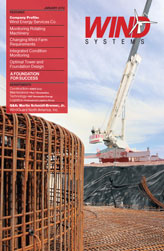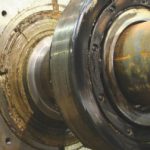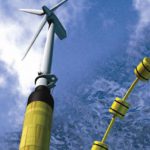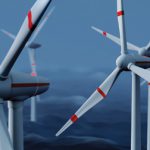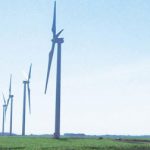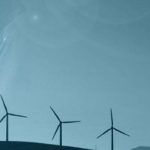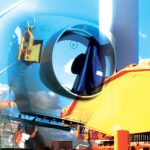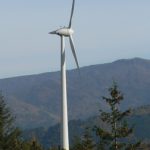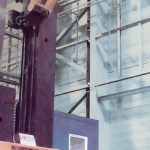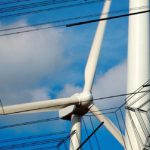The winds of change may soon affect wind turbine design. Moog recently conducted a worldwide survey of wind farm operators and wind turbine builders to better understand their needs vis-à-vis blade pitch control. We found that, excluding macroeconomic forces, there are three trends likely to affect the design of wind turbines in the medium term. First, the world will see new wind farms in hard-to-reach areas with harsh weather conditions. Second, wind power will account for a larger part of total electricity supply. And third, there will be an increased focus on improving turbine efficiency, especially in mature markets.
Addressing these issues while maintaining rapid growth will be challenging. Wind turbine builders will need to nurture mutually beneficial relationships with key subsystem suppliers in order to improve performance, while increasing production volume and expanding their geographical scope.
Offshore and Elsewhere
As wind energy grows in importance, new wind farms will increasingly be located in harsh environments that are difficult to reach. Offshore installations present particularly difficult issues. Offshore wind capacity is growing fast, with 13,500MW of new capacity expected to be installed globally between 2010 and 2014 [1]. The current generation of offshore wind turbines face strong wind conditions and waves one meter high or more. Figure 1
As the number of offshore wind farms grows, operators and owners are likely to locate these farms in deeper waters and further from shore. In the United Kingdom, for example, the average maximum depth of water in which wind turbines are located is projected to increase from 15.6 meters for projects commissioned between 2005 and 2009 to 27.1 meters for those commissioned between 2010 and 2014. Similarly, the distance from shore is projected to increase from 9.1 kilometers to 19.8 kilometers [2].
A similar trend will apply to onshore wind farms, with new wind farms increasingly being located in remote locations with harsh climates. China, for example, has declared its intention to create seven wind power bases with a capacity of at least 10GW each by 2020. Two of these are in Eastern and Western Inner Mongolia. Inner Mongolia is bitterly cold, with long winters during which temperatures can drop as low as -23°C. Blizzards are common in winter and there are frequent sand storms during the short summer.
Total Electricity Supply
In its reference scenario, which assumes that there are no major changes in energy policy, the International Energy Agency (IEA) expects wind power as a percentage of total electricity generated globally to increase from 0.9 percent—the share in 2007—to 3.7 percent in 2020, and 4.5 percent in 2030. Under its 450 scenario, which assumes that countries take coordinated action to control greenhouse gas emissions, the share of wind increases to 5.1 percent in 2020 and 9.3 percent in 2030 [3].
The share of wind in Europe will be significantly higher than the world average. The IEA projects the share rising to 14.6 percent in 2030 in its reference scenario and to 20.1 percent in its 450 scenario for the European Union. The shares in Denmark and Spain are likely to be even higher than this (Figure 1).
Increasing Scale
The scale of wind farms is also increasing, with 50+ MW wind farms becoming more common. This is especially true for China, the U.S., and offshore installations. In addition, clustering of wind farms within a region will become more common (e.g., China). The growing scale of wind farms increases their impact at a local level, since they account for a larger share of total electricity production within a region. Wind turbines are also expected to become larger in size. The average wind turbine size increased to 1,599 kW in 2009. It is likely to increase further as operators install larger turbines in new locations and they replace existing wind turbines in Europe with new models.
Repowering of older, smaller wind turbines in mature European markets like Denmark, Spain, and Germany to increase output from high quality sites will accentuate this trend. Survey respondents generally agreed that repowering would gain importance in Europe. “Some wind parks are almost 10 years old, so we will see a lot of them being repowered in the next 10 years,” according to a European wind turbine builder. “This is currently occurring on a small scale in Denmark and Germany.”
“In Europe, land is restricted and many plants are aged,” a U.S. turbine manufacturer adds. “Therefore, they will have to be replaced.”
As wind’s share of total power generation rises, operators will require accurate wind power predictions to schedule the operation of other generation resources. This becomes important when wind energy’s share of installed capacity reaches 5 percent, and critical at 10 percent.
Focus on Efficiency
The top 15 wind farm operators accounted for 35 percent of total wind power capacity in 2008, versus 23 percent in 2003 [4]. Utilities will continue to increase their share of wind power capacity since they are cash rich and do not face the financial constraints that developers do.
The growing role of utilities in wind power is leading to a greater focus on efficiency. They are demanding reliable solutions and will focus more on energy efficiency, uptime and O&M cost management. Respondents to our research questions generally agreed that operators were increasing scale in wind power and would demand higher levels of operational efficiency. A representative of a European consulting firm laims that large energy suppliers will become the main operators of wind farms, which means that requirements in terms of quality and efficiency will become more demanding. A European wind turbine builder adds that “The more plants they operate, the more they are forced to address efficiency.”
These trends are likely to change the factors that wind farm operators manage and measure and, therefore, the attributes they look for in the wind turbines they purchase. There was general agreement among survey respondents that reliability was becoming more important in influencing the purchase decisions of operators. Operators want more output and there is a trend toward larger wind turbine systems. However, when breakdown or failure occurs, the larger the system the bigger the loss. In other words, reliability and uptime are extremely important. Or, according to a U.S. manufacturer, “Technical availability is more important, even if the price of the turbine is higher. Our contracts guarantee technical availability and actual performance. If these are not fulfilled, we provide rectification or compensation or both.”
Reliability is seen by survey respondents as especially important for offshore installations, since these can be difficult and expensive to access in the event of a failure. Condition monitoring systems—which usually monitor the gearbox, bearings, and generator—are likely to become more widely adopted in the future for a number of reasons.
First, the growing size of wind turbines exposes operators to greater loss of revenue in the event of failure, as well as the cost of repair. Operators are therefore more willing to invest in monitoring systems so they can detect potential problems early, carry out preventive maintenance, and minimize downtime. “The other important factor is the size of the turbine,” according to the operator of a wind farm in the U.S. “If I have a $2 million machine and the gearbox costs $500,000, then I definitely want to use condition monitoring.”
Second, operators feel that condition monitoring is more essential for offshore installations than for onshore because of poor accessibility and the high cost of maintenance. The growth of offshore wind farms will therefore lead to growth in condition monitoring. The main objective is to keep mean time between failures (MTBF) as low as possible, especially for offshore installations, since maintenance for offshore involves more cost and more risk. Condition monitoring is therefore essential, especially for offshore parks with limited access.
Third, operators see a greater need for conditioning monitoring for wind turbines located in harsh environments. The proportion of wind turbines in such locations is likely to grow over time. As a European wind farm operator explains, “If the turbine is located in a very windy environment, the probability of it breaking down is high, so we would install a condition monitoring system on a windy site.”
Fourth, insurance companies are increasingly requiring condition monitoring systems for offshore turbines and may offer favorable terms for onshore turbines with these. And finally, large utilities are more willing to invest in condition monitoring systems, since they have used these for other forms of power generation and understand the value they provide.
Focus on Pitch Control
Accurate forecasts and the ability to conform to the grid code will grow in importance as the share of wind power in electricity generation increases. Some of these requirements can be met by varying the output from the wind farm, which can be done relatively easily if the wind farm uses pitch-controlled wind turbines. The increasing interest in improving turbine efficiency in mature markets is also likely to stimulate interest in pitch systems, since these can help improve turbine operation through reduced friction, better wind utilization, or both.
The growing size of wind turbines will also increase the importance of pitch systems because of their role in managing loads, which reduces wear on components, minimizes downtime and increases lifetime. Individual pitch control, which dynamically adjusts the pitch of each blade in real time to optimize rotor loading, is also likely to be more widely adopted in the future. Survey respondents expressed strong interest in this new technology. A Japanese wind farm operator says that “More precise response to wind conditions would enhance life-time and revenue of the wind turbine, and is therefore desirable.”
Conclusions
Wind turbine builders will need to cost-effectively address the changing requirements of wind farm operators to remain competitive. The key issues wind turbine builders need to address include:
• Finding a cost-effective response to the need for greater reliability. Pitch control will be a key system that requires more attention;
• Catering to the likely increase in need for condition monitoring;
• Assisting wind farm operators to satisfy increasingly stringent grid code requirements.
Addressing these challenges and satisfying customer expectations is challenging. Wind turbine builders are unlikely to do it alone. Developing mutually beneficial relationships with subsystem suppliers who understand these requirements is a key to success.
References:
1) World Market Update 2009. BTM Consult, March 2010
2) UK Offshore Wind-Charting the Right Course. BWEA
3) World Energy Outlook 2009. International Energy Agency
4) World Market Update 2009. BTM Consult, March 2010



















